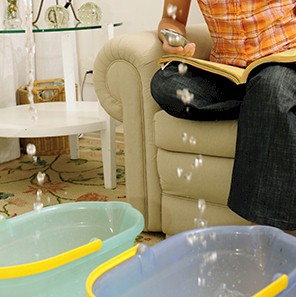While it is true that accidental flooding is more common in the winter months, it can happen anytime throughout the year. Luckily, there are some simple steps you can take to prevent that from happening. Listed below are 10 easy ways to prevent accidental flooding in your home.
1 – Get Your Roofing Inspected
Roof inspections are just as important as plumbing inspections when it comes to accidental flooding. You want to make sure that your roof is free of leaks, holes, or weak spots that could flood your home in a heavy rain storm. If any of your roofing needs to be repaired or replaced, fix it before the storms come.
2 – Clean Your Gutters
Clogged guttering may direct rainfall from your roof into places you do not want it to go. If it puddles up near your front door, garage, basement, etc., you may be facing an unexpected flood. Clean your gutters at least twice a year, before and after fall. This will clear the debris and make room for the water to flow.
3 – Check Your Toilets
If your toilets are not flushing properly, you may want to have them inspected or repaired. This is the one fixture in your home that is most likely to flood because it supports high volumes of water all throughout the day. If your toilet is clogged, clear out the clog before you use it again.
4 – Monitor Children at Bath Time
If you leave your child unattended during bath time, he can easily flood the bathroom. Most bathtubs have drainage holes new the rim, but if the water is rushing in fast enough, that will not be enough. Keep an eye on your children at bath time to make sure they do not turn the water up too high.
5 – Watch the Weather
Above all else, you must be informed about the weather in your area. Prepare for cold fronts, rain storms, tornadoes, hurricanes, and anything else that may bring water or coldness into your home. This will help you avoid accidental flooding for years to come.
6– Keep Your Heat Running
Your home should be kept at a minimum of 60 degrees in the winter months to avoid freezing your pipes. If you have a vacant home that you do not visit anymore, you should still keep your heat running at a low temperature.
7 – Drip Your Faucets
Leave your faucets on a slow, constant drip. This will keep water flowing through your plumbing, which may eliminate cracks due to cold weather.
8 – Open Your Cabinets
Opening your cabinets will allow more heat to get to your plumbing, which again will minimize your risk of flooding. Keep the doors open to all of your bathrooms so they can benefit from the heat in the rest of the home.
9 – Insulate Your Plumbing
You can wrap your pipes in foam insulation to keep them warm. You can hire a handyman to do this if you do not feel comfortable with it.
10 – Get Your Plumbing Inspected
Allow a professional to come to your home and assess the structural integrity of your piping. This person should be able to identify cracks and leaks before they happen or before they get bad enough to cause a flood. Regular maintenance and inspections will ensure that your home is protected from accidental flooding in the future.

